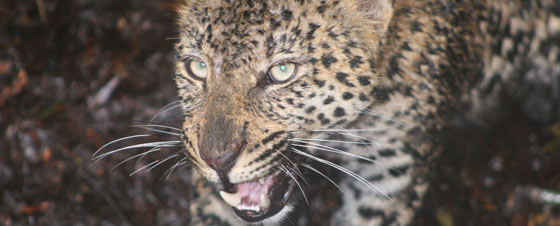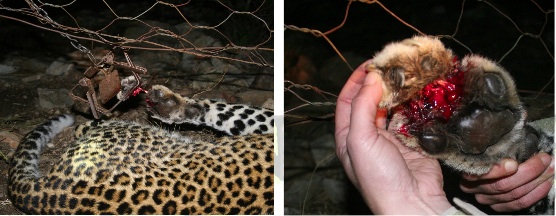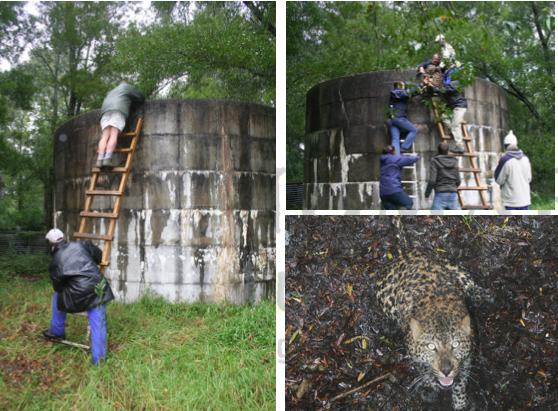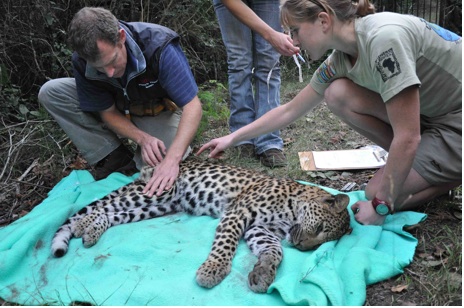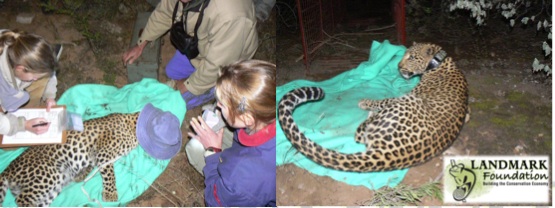|
|
|
29 JUNE 2010 While 2010 has
so far been a mixed bag of success and failure for predator and
biodiversity conservation, the Landmark team have been hard at work in
their respective areas and finding more ground for leopards, predators and
biodiversity conservation.
Since our last
newsletter in April 2010 we must sadly update you on the 31st leopard
known to be killed in the region, and in this case as a result of a gin
trap. In this time a further 6 leopards have additionally been
successfully rescued too. We have now rescued 34 leopards, of which 17
leopards have been GPS collared in the Eastern and Western Cape since
2004. Our team has
grown with new field workers allowing us to cover more ground. Livestock
protection research trials have extended into the Karoo. Education
programs and awareness initiatives have also expanded.
Leopard Captures There have been
7 leopard rescues and captures over the last two months.
OUTRAGE! It is indeed
an indictment of our conservation policies and South African farming
practices that gin traps is still so commonplace. In early June another
leopard was caught
in a gin trap and died in the Winterhoek Mountains, near
Willowmore. The leg hold devices (as the state wish to euphemise them now,
or worse still, "soft catch traps", is currently being written into
legislation. It is proposed that by placing a bit of cotton wool/rubber on
their jaws these traps are now rendered "harmless" and "soft". Sadly
nothing could be further from the truth as yet again, we have had to
witness the death of a leopard due to these "soft" devices...
This leopard is
death no 31 that we have had to witness!
This
demonstrates the indiscriminate and barbaric nature of these devices.
hese barbaric
devices remain an integral part of red meat, wool and mohair production in
South Africa. Vote with your wallets when you consider purchasing such
products, and support producers that conserve our wildlife and act
ethically. Pressure your supermarket to support ecologically friendly and
ethical production practices. This cat was a beautiful male leopard
probably just over 2 years old, weighing 28 kg's. He was probably a young
maturing dispersal leopard, making him even more vulnerable to death by
gin-trap as he would be traversing large areas in order to establish a
range of his own. His left
paw was caught in
the gin-trap and he lost two toes, which fell off his foot as soon as we
removed the device. Ironically this was a 'soft
gin-trap' (sans the cottonwool) which government wishes to legalise (and
rename) as an alternative to "conventional" gin-traps.
After initially rescuing the cat, it cardiac arrested twice, with the
second event it died after the initial resuscitation succeeded. The cause
of death was a combination of hypothermia (it was raining/snowing, and had
been in the trap between 24 and 36 hours), shock and stress, and probably
in combination with anaesthetic effects in the emergency setting resulting
in cardiac arrest. Two veterinarians and a medical doctor attended to the
failed rescue.
The area where
the cat was killed is adjacent the Baviaanskloof Reserve where research
has demonstrated that a population of about 30 - 35 resident leopards
remain and that are in all likelihood genetically isolated. This cat would
have been a juvenile dispersal individual. The genetic link he would have
provided to other isolated populations and has now been destroyed, making
it a tragic loss to the population viability in the region. This
indiscriminate removal of a healthy, non-problem causing individual in
this World Heritage Site region is devastating for leopard conservation
efforts. We hear constant unsubstantiated rumours of several more leopards
being taken out in the region through gin traps, poisons and hunting dogs
– all methods being proposed to be retained in current draft
legislation. The loss of
this leopard was difficult to deal with and it is important to remember
that this is a reality in our landscape and will remain this way for
future generations due to current draft legislation about to go out to
public comment where these devices will remain legal instruments of
slaughter of our biodiversity. These practices remain an
integral part of rangeland red meat, wool and mohair production.
Consumers have
the power to change this through their actions at supermarket tills.
We call on all
parties interested this matter to send the protest messages to the person
responsible for drafting of the legislation/regulations:
Ask them to
specifically prohibit the use of gin traps, leg hold devices, soft catch
traps, poisons, and hunting dogs as a means to try to manage damage
causing animals in all impending legislative standards and regulations.
Request that all damage causing animal actions become subject to permitted
conditions. Once the draft
norms and standards in relation to damage causing animals are published
for public comment, we will issue a reminder to comment.
Don't stop
putting pressure on government and the agricultural sector to stop these
ecologically damage and ethically unacceptable production practices.
Despite years of request, no retailer has to date commited to stocking
produce that is free of these practices. You can contact meat, wool an
mohair retailers such as Woolworths, P'nP, Spar, Checkers, Shoprite and
Fruit and Veg to stock predator and biodiversity friendly meat and animal
fibre products so that you know you support producers who use wildlife
friendly means of predator controls (see more at www.fairgame.org.za).
Another recent
and bizarre rescue followed the events described above. Following the
disappointment on the loss of the male leopard, we got a call from Cape
Nature of a leopard capture in Heidelberg under unusual circumstances. A
male leopard had chased a baboon into a tree, and they both fell from the
tree into an empty water reservoir about 8 meters deep. Neither could
escape. The leopard ate the baboon, but could not then get out of the
reservoir. The veterinarians from Riversdale were able to assist us with
the capture. The leopard was sedated and once he was fully asleep was
lifted out of the reservoir.
Once the
leopard was safely on the ground, we could assess his condition. We kept
him warm with hot-water bottles while we got DNA and morphological data
before collaring him and releasing him. The fully grown adult leopard
(about 40 kg's) was released back onto the farm with a GPS collar. We look
forward to tracking this cat and getting to know the Heidelberg area and
its residents. On the 5th
June, a beautiful sub-adult male
leopard was captured in a Knysna forest. At 23 kg's he was
not fully grown and thus we didn't collar him, but we did obtain important
morphological data and DNA. By comparing his size to his counterparts in
the area, he still has another approximate 20 kg's to grow, and is
probably only about 18 months old! We will continue to capture and collar
leopards in the forest in order to better understand them. Thanks to Dr.
Brendan Tindall for his assistance.
An adult female
was captured and collared in the Baviaanskloof on the 28th May. She was a
fully grown adult of 23 kg's (average weight of adult females in the
region). Thanks to Dr. Martin Bootsma who again assisted with the darting
of the animal, and the farmers in the Baviaanskloof who are living
alongside these amazing creatures.
A juvenile
leopard was captured
and released without darting in the Baviaanskloof Reserve early in May. It
was not possible to determine the sex of the youngster, but it is in
excellent condition. We estimate it weighed in the region of 16kg's and is
approximately 6-8 months old. Special thanks to Gavin Shaw and his staff
for managing this cage for us daily. Bi-annual project update The research
and extension work area has expanded its range and has now grown to an
area of over 40000km2! (4 million hectares!) This is an extremely large
area stretching from Port Elizabeth in the east and presently to
Heidelberg in the west, and north to Middleburg. With the expansion of the
project area, the Landmark Team has also grown: The Karoo
Research: Dr. Anna Haw is
a qualified veterinarian undertaking her Masters in Science Extending the
project into the Karoo districts of Nieu Bathesda, Middleberg,
Jansenville, Prince Albert and Victortia West, Anna is gathering
information on how herd health is related to livestock mortality and
predation. Farmers are also being supplied with predator deterrents such
as guarding dogs, alpacas (animal closely related to lama's), jackal and
ultrasonic alarms, and different livestock collars to deter predation to
livestock. Since the astonishing results of the preliminary study (see
below under management) this study is being implemented to test the
efficacy and economic impact of various non-lethal predator control
methods on small stock farms over large areas, and against lethal
controls. The ultimate goal is to identify methods of farming which are
ethically acceptable and environmentally friendly while also ensuring
improved production percentages are achieved by livestock farmers. This is
key to ensuring a healthy environment and creating biodiversity-friendly areas
outside of protected areas of South Africa.
The Eastern and
Western Cape:
Leopards are
showing varying degrees of range size requirements from 60 000 hectares in
the mountainous Baviaanskloof to 10 000 hectares in the Southern Cape
forests. Leopards are limited by suitable space as they are very
territorial and males show negligible degrees of home range overlap while
females are strictly territorial, not allowing other females within the
area. Females ranges are typically covered by only one male, but several
females may fall within one males range. The population size in the
Baviaanskloof mountains (300 000 hectares) is merely 30 – 35 adult
leopards, while in the Garden Route leopard populations may be as low as
between 22 – 26 adults! They show a major preference for utilising
forest habitats to the exclusion of other habitats. With merely 60 000
hectares of indigenous forests remaining in the Garden Route, of which
much of this is already fragmented into tiny patches, leopards are in need
of conservation and our research is providing important information to
managers and policy makers. It is suspected that habitat fragmentation has
largely isolated these populations (Baviaanskloof and Garden Route) and
with the small remaining populations these animals are genetically in a
bottleneck. Finding corridor connections between populations for their
genetic viability is critical to their survival locally.
Each of the
areas offer different threats and advantages to the leopards and we are
currently investigating population density and dynamics, corridors
connecting potentially isolated leopard populations, diet and hunting
behaviour within different areas. From scat (leopard droppings) we are
finding that bushbuck make up an important component of leopards diet in
forests, while in the Baviaanskloof area, they seem to be slightly more
opportunistic, eating animals such as mountain reedbuck to dassies and
birds. Camera Traps
In the
Baviaanskloof we identified a river willow (Combretum) with fresh scratch
marks from leopard so we placed a camera there in order to obtain some
idea on who is marking and what kind of effect this may have on other
leopards and animals walking past. We captured a big male in the
Baviaanskloof marking the tree. A gorgeous
photo was taken of an uncollared male in the Knysna forest drinking from a
pool of water. This one was too spectacular not to share. He neighbours
one of the collared males in the area and we hope to collar him
soon.
Management: Results from research Emerging
research indicate that the use of non-lethal predator control (guard
animals, deterrents and aversive stimuli) reduce livestock losses more
effectively than lethal control methods (hunting, gin-traps, poisons).
Results from 12 farms and the monitoring of 16100 livestock in the Eastern
Cape (Graaff Rienet, Jansenville, Cockscomb and Baviaanskloof areas)
indicate improvements in livestock production from 53 – 97% when lethal
controls were replaced by non-lethal controls (McManus, J and Macdonald,
D, in prep). This benefits biodiversity on farmlands and ensures farmers
are more productive simply by working with nature. Education and
Awareness: Kate Muller has
initiated and developed the education program over the last
year. This has
involved school children, the agricultural sector and the general public.
Kate has visited many schools in the Eastern and Western Capes. We have
engaged over 1500 scholars to date, spending lots of time in classrooms
and in the field with classes from Gr 0 to Gr 12 educating them about
leopards, other predators and biodiversity conservation and explaining how
students can help conservation. The students were enthralled and eager to
help. After the talks some of the students became creative and made
striking art works showing their respect for nature and their will for
conserving their heritage! A key message in the education drive is that
everyone plays part in conservation. Some scholars have taken this to
heart and have started their own research using cameras in the field. They
are also running awareness and fundraising activities to assist leopard
and predator conservation.
Art for
Conservation is running again this year! Above are some of the entries we
received from 2009's "Leopard Art".If you would like Kate and the team to
visit your school please contact her on 082 462 8598 / email:
kate@landmarkfoundation.org.za for a full outline of what the program
offers. Spreading the
Word
Coming
Soon Release of an
exclusive Leopard T-shirt Range is coming to Billabong outlets on 1st July
2010. Get yours now and support leopard conservation in fashion. Visit http://www.billabong.com/girls/za/
and follow the change your spots link.
Racing for
Leoaprds in the Trans-Baviaans 24hr Mountain Bike Challenge. Get your
cycling gear from Landmark Foundation and join the race to save leopards.
Contact kate@landmarkfoundation.org.za to place your
orders.
Leopard crawl
trail has been set up in Wilderness by Mark Dixon of Garden Route Trails.
Visit www.gardenroute.co.za trails.co.za. Sponsors Thank you to
all our sponsors who are caring for biodiversity. Our work would be
impossible without you. Recent support have come from Eden District
Municipality, Deutsche Bank Foundation, Mones Michaels Trust, Abax
Foundation and National Lotteries Distribution Trust Fund.
Do Want to
help? We run an
expensive project and are always grateful to receive assistance with our
endeavours. We are a registered charitable Trust (a NGO) and are
registered with the Department of Social Development and as a tax exempt
entity with SARS. We can thus provide a TAX exemption/deductible
certificate on any cash donations made. Should you want
to assist us in other ways feel free to contact us
directly:
In particular:
|
|
Issued
by: Dr Bool Smuts,
Director Landmark Foundation |

